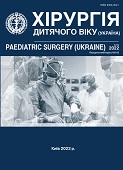Endoscopic resection of bladder urothelial neoplasm in a child: a case report
DOI:
https://doi.org/10.15574/PS.2022.75.89Keywords:
bladder neoplasm, transcutaneous cystoscopy, neuromuscular bladder dysfunction, childrenAbstract
Bladder tumour, especially urothelial neoplasm, is a very rare condition in paediatric age. That is why true and accurate information on biological grade of malignancy and, correspondingly, the surgical management is absent. However, the majority of physicians take the view that this type of tumour has a low grade of malignization and recurrence, even after the endoscopic excision of neoplasm in paediatric patients.
Purpose - to describe a clinical case of surgical management of the bladder urothelial neoplasm in a child by means of minimally invasive equipment.
Clinical case. Endoscopic methods of surgical treatment are widely used in paediatric patients with the urinary tract conditions in our clinic. The transcutaneous surgical treatment of bladder conditions has been employed in paediatric patients since 2010. For example, it was used for the removal of ureterolith impacted in the bladder neck and foreign bodies of the bladder, as well as the bladder urothelial neoplasm excision.
We also tried to use it for visualisation of the posterior urethra rupture length through a cystoscope, which was put into the epicystostomic hole of the posterior urethra together with the simultaneous urethroscopy (for the purpose of the directed illumination during the urethroscopy). However, due to the long length of the posttraumatic urethrostenosis, it was impossible to achieve the illumination and catheterisation of the urethra during the urethroscopy in the site of damage.
The clinical case of the minimally invasive resection of the bladder urothelial neoplasm in a child is presented in the article.
Minimally invasive techniques give the opportunity to perform even the radical operations with the perfect cosmetic result and minimal injury that is very important in the paediatric patients.
The research was carried out in accordance with the principles of the Helsinki Declaration. The informed consent of the patient was obtained for conducting the studies.
No conflict of interests was declared by the authors.
References
Apoznański W, Rysiakiewicz J, Polok M, Rysiakiewicz K et al. (2015). Transurethral Resection of the Bladder Tumour as a Treatment Method in Children with Transitional Cell Carcinoma of the Bladder - Analysis of Our Material and Literature Review. Adv Clin Exp Med. 24(3): 505-509. https://doi.org/10.17219/acem/36600; PMid:26467141
Berrettini A, Castagnetti M, Salerno A, Nappo SG, Manzoni G, Rigamonti W, Caione P. (2015). Bladder urothelial neoplasms in pediatric age: Experience at three tertiary centers. Journal of Pediatric Urology. 11(1): 26. https://doi.org/10.1016/j.jpurol.2014.08.008; PMid:25305695
Campo G, Giannarini G, Pomara G, Manassero F, Pistolesi D, Selli C. (2012). Bladder papilloma in a 9-year-old girl: a case report. Minerva Pediatr. 64(3): 361-3. PMID: 22555331.
Gabr AH, Elbadry M, Elsherief A, Tawfiek ER. (2013). Computed tomography-virtual cystoscopy in the evaluation of a bladder mass: Could it replace standard conventional cystoscopy? Arab J Urol. 11(4): 369-374. https://doi.org/10.1016/j.aju.2013.06.007; PMid:26566456 PMCid:PMC4582599
Fine SW, Humphrey PA, Dehner LP, Amin MB, Epstein JI. (2005). Urothelial neoplasms in patients 20 years or younger: a clinicopathological analysis using the world health organization 2004 bladder consensus classification. J Urol. 174(5): 1976-80. https://doi.org/10.1097/01.ju.0000176801.16827.82; PMid:16217372
Gao L, Tang DX, Li MJ, Xu S. (2014). Papillary Urothelial Neoplasm of Low Malignant Potential in a 9-year-old Boy: A Case Report. HK J Paediatr (new series). 19: 262-264.
Jurkiewicz B, Shevchuk D, Załęska K. (2017) Relationship between urothelial metaplasia and neuromuscular bladder dysfunction in children. Paediatric Surgery (Ukraine). 3(56): 84-88 https://doi.org/10.15574/PS.2017.56.84
Litchinko A, Meyrat BJ, Nobile A, Raffoul L, Dushi G, Estremadoyro V. (2016). Hematuria in a 12-year-old child, a rare case of urothelial papilloma of the urinary bladder. J Ped Surg Case Reports. 7: 45-47. https://doi.org/10.1016/j.epsc.2016.02.011
Patel R, Tery T, Ninan GK. (2008). Transitional cell carcinoma of the bladder in first decade of life. Pediatr Surg Int. 24(11): 1265-8. https://doi.org/10.1007/s00383-008-2251-4; PMid:18813937
Pati A, Sahoo RK, Mahapatra A. (2016). Urothelial Carcinoma in Pediatric Patient. Indian J Surg. 78: 229-231. https://doi.org/10.1007/s12262-015-1384-7; PMid:27358519 PMCid:PMC4907911
Polat H, Utangac MM, Gulpinar MT, Cift A, Erdogdu IH, Turkcu G. (2016). Urothelial neoplasm of the bladder in childhood and adolescence: a rare disease. Int Braz J Urol. 42: 242-6. https://doi.org/10.1590/S1677-5538.IBJU.2015.0200; PMid:27256177 PMCid:PMC4871383
Rifat UN, Hamadalla NY, Safi KCC, Al Habash SS, Mohammed M. Urothelial bladder tumour in childhood: A report of two cases and a review. Arab J Urol. 2015;13(2):116-121. https://doi.org/10.1016/j.aju.2014.11.002; PMid:26413332 PMCid:PMC4561878
Shevchuk D. (2018). Mini-invasive surgery on the lower urinary tract for neuromuscular bladder dysfunction in children. Paediatric Surgery (Ukraine). 3(60): 80-84. https://doi.org/10.15574/PS.2018.60.80
Shevchuk D.V. (2016). A Rare Case of Urethral Caruncle Complicated with Neuromuscular Bladder Dysfunction in a 9-Year-Old Girl. Paediatric Surgery (Ukraine). 1-2 (50-51): 97-100. http://www.mif-ua.com/archive/article/43586.
Shevchuk DV, Rusak PS, Vyshpinskyi IM, Zaremba VR. (2015). Zastosuvannia cherezshkirnoi tsystoskopii pry vydalenni storonnoho tila u dytyny, khvoroi na nervovo-m'iazovu dysfunktsiiu sechovoho mikhura. Naukovyi visnyk Uzhhorodskoho universytetu (seriia Medytsyna). 2(52): 124-129. http://nbuv.gov.ua/UJRN/UNUMED_2015_2_29.
Thomas G, Gera P, Arbuckle S, Cohen R. (2006). Transitional cell papilloma of the bladder in a child: A case report and review of literature. Journal of Pediatric urology. 2(1): 59-62. https://doi.org/10.1016/j.jpurol.2005.05.009; PMid:18947598
Downloads
Published
Issue
Section
License
Copyright (c) 2022 Paediatric Surgery (Ukraine)

This work is licensed under a Creative Commons Attribution-NonCommercial 4.0 International License.
The policy of the Journal “PAEDIATRIC SURGERY. UKRAINE” is compatible with the vast majority of funders' of open access and self-archiving policies. The journal provides immediate open access route being convinced that everyone – not only scientists - can benefit from research results, and publishes articles exclusively under open access distribution, with a Creative Commons Attribution-Noncommercial 4.0 international license(СС BY-NC).
Authors transfer the copyright to the Journal “PAEDIATRIC SURGERY.UKRAINE” when the manuscript is accepted for publication. Authors declare that this manuscript has not been published nor is under simultaneous consideration for publication elsewhere. After publication, the articles become freely available on-line to the public.
Readers have the right to use, distribute, and reproduce articles in any medium, provided the articles and the journal are properly cited.
The use of published materials for commercial purposes is strongly prohibited.

